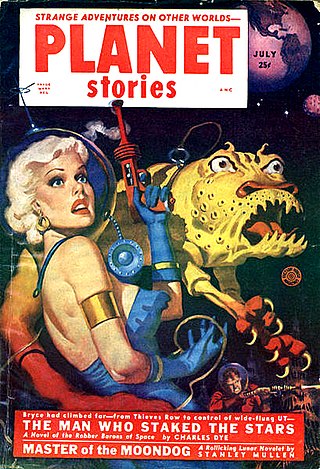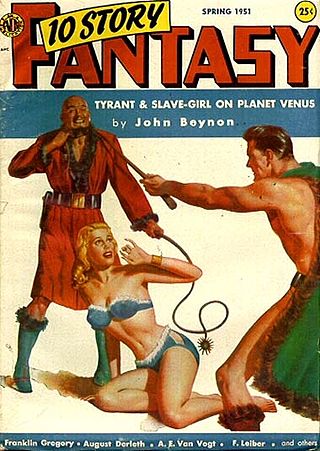Related Research Articles
Magic realism or magical realism is a style of literary fiction and art. It paints a realistic view of the world while also adding magical elements, often blurring the lines between fantasy and reality. Magic realism often refers to literature in particular, with magical or supernatural phenomena presented in an otherwise real-world or mundane setting, commonly found in novels and dramatic performances. Despite including certain magic elements, it is generally considered to be a different genre from fantasy because magical realism uses a substantial amount of realistic detail and employs magical elements to make a point about reality, while fantasy stories are often separated from reality. Magical realism is often seen as an amalgamation of real and magical elements that produces a more inclusive writing form than either literary realism or fantasy.

Rudolf von Bitter Rucker is an American mathematician, computer scientist, science fiction author, and one of the founders of the cyberpunk literary movement. The author of both fiction and non-fiction, he is best known for the novels in the Ware Tetralogy, the first two of which both won Philip K. Dick Awards. Until its closure in 2014 he edited the science fiction webzine Flurb.
Damien Francis Broderick is an Australian science fiction and popular science writer and editor of some 74 books. His science fiction novel The Dreaming Dragons (1980) introduced the trope of the generation time machine, his The Judas Mandala (1982) contains the first appearance of the term "virtual reality" in science fiction, and his 1997 popular science book The Spike was the first to investigate the technological singularity in detail.
The fantastic is a subgenre of literary works characterized by the ambiguous presentation of seemingly supernatural forces.

"Beyond Lies the Wub" is a science fiction short story by American writer Philip K. Dick. It was his first published genre story, originally appearing in Planet Stories in July 1952. It was first collected in The Preserving Machine in 1969, and was included in The Best of Philip K. Dick in 1977. It was the title story for the first volume of the original edition of Dick's collected stories. Translations of "Beyond Lies the Wub" have appeared in Dutch, French, German, Italian, Polish and Spanish; and the story has been included in more than a dozen anthologies.
Postmodern literature is a form of literature that is characterized by the use of metafiction, unreliable narration, self-reflexivity, intertextuality, and which often thematizes both historical and political issues. This style of experimental literature emerged strongly in the United States in the 1960s through the writings of authors such as Kurt Vonnegut, Thomas Pynchon, William Gaddis, Philip K. Dick, Kathy Acker, and John Barth. Postmodernists often challenge authorities, which has been seen as a symptom of the fact that this style of literature first emerged in the context of political tendencies in the 1960s. This inspiration is, among other things, seen through how postmodern literature is highly self-reflexive about the political issues it speaks to.

Fantasy literature is literature set in an imaginary universe, often but not always without any locations, events, or people from the real world. Magic, the supernatural and magical creatures are common in many of these imaginary worlds. Fantasy literature may be directed at both children and adults.
Literary fiction, mainstream fiction, non-genre fiction or serious fiction is a label that, in the book trade, refers to market novels that do not fit neatly into an established genre ; or, otherwise, refers to novels that are character-driven rather than plot-driven, examine the human condition, use language in an experimental or poetic fashion, or are simply considered serious art.
The timestream or time stream is a metaphorical conception of time as a stream, a flowing body of water. In Brave New Words: The Oxford Dictionary of Science Fiction, the term is more narrowly defined as: "the series of all events from past to future, especially when conceived of as one of many such series". Timestream is the normal passage or flow of time and its historical developments, within a given dimension of reality. The concept of the time stream, and the ability to travel within and around it, are the fundamentals of a genre of science fiction.
The slipstream genre is a term denoting forms of speculative fiction that do not remain in conventional boundaries of genre and narrative, directly extending from the experimentation of the New Wave science fiction movement while also borrowing from fantasy, psychological fiction, philosophical fiction and other genres or styles of literature.
The New Weird is a literary genre that emerged in the 1990s through early 2000s with characteristics of weird fiction and other speculative fiction subgenres. M. John Harrison is credited with creating the term "New Weird" in the introduction to The Tain in 2002. The writers involved are mostly novelists who are considered to be part of the horror or speculative fiction genres but who often cross genre boundaries. Notable authors include K. J. Bishop, Paul Di Filippo, M. John Harrison, Jeffrey Ford, Storm Constantine, China Miéville, Alastair Reynolds, Justina Robson, Steph Swainston, Mary Gentle, Michael Cisco, Jeff VanderMeer and Conrad Williams, among others.

Elements of the supernatural and the fantastic were an element of literature from its beginning. The modern genre is distinguished from tales and folklore which contain fantastic elements, first by the acknowledged fictitious nature of the work, and second by the naming of an author. Works in which the marvels were not necessarily believed, or only half-believed, such as the European romances of chivalry and the tales of the Arabian Nights, slowly evolved into works with such traits. Authors like George MacDonald created the first explicitly fantastic works.
Slice of life is a depiction of mundane experiences in art and entertainment. In theater, slice of life refers to naturalism, while in literary parlance it is a narrative technique in which a seemingly arbitrary sequence of events in a character's life is presented, often lacking plot development, conflict and exposition, as well as often having an open ending.

Mundane science fiction (MSF) is a niche literary movement within science fiction that developed in the early 2000s, with principles codified by the "Mundane Manifesto" in 2004, signed by author Geoff Ryman and "The Clarion West 2004 Class". The movement proposes "mundane science fiction" as its own subgenre of science fiction, typically characterized by its setting on Earth or within the Solar System; a lack of interstellar travel, intergalactic travel or human contact with extraterrestrials; and a believable use of technology and science as it exists at the time the story is written or a plausible extension of existing technology. There is debate over the boundaries of MSF and over which works can be considered canonical. Rudy Rucker has noted MSF's similarities to hard science fiction and Ritch Calvin has pointed out MSF's similarities to cyberpunk. Some commentators have identified science fiction films and television series which embody the MSF ethos of near-future realism.

Terence William (Terry) Dowling, is an Australian writer and journalist. He writes primarily speculative fiction though he considers himself an "imagier" – one who imagines, a term which liberates his writing from the constraints of specific genres. He has been called "among the best-loved local writers and most-awarded in and out of Australia, a writer who stubbornly hews his own path ."
Science fiction studies is the common name for the academic discipline that studies and researches the history, culture, and works of science fiction and, more broadly, speculative fiction.
Van Ikin is an academic and science fiction writer and editor. A professor in English at the University of Western Australia, he retired from teaching in 2015 and is now a senior honorary research fellow. He has acted as supervisor for several Australian writers completing their post-graduate degrees and doctorates — including science fiction and fantasy writers Terry Dowling, Stephen Dedman, and Dave Luckett — and received the university's Excellence in Teaching Award for Postgraduate Research Supervision in 2000.

A. Merritt's Fantasy Magazine was an American pulp magazine which published five issues from December 1949 to October 1950. It took its name from fantasy writer A. Merritt, who had died in 1943, and it aimed to capitalize on Merritt's popularity. It was published by Popular Publications, alternating months with Fantastic Novels, another title of theirs. It may have been edited by Mary Gnaedinger, who also edited Fantastic Novels and Famous Fantastic Mysteries. It was a companion to Famous Fantastic Mysteries, and like that magazine mostly reprinted science-fiction and fantasy classics from earlier decades.

10 Story Fantasy was a science fiction and fantasy pulp magazine which was launched in 1951. The market for pulp magazines was already declining by that time, and the magazine only lasted a single issue. The stories were of generally good quality, and included work by many well-known writers, such as John Wyndham, A.E. van Vogt and Fritz Leiber. The most famous story it published was Arthur C. Clarke's "Sentinel from Eternity", which later became part of the basis of the movie 2001: A Space Odyssey.
References
- ↑ Broderick, Damien (2000). Transrealist Fiction: Writing in the Slipstream of Science. Westport, CT: Greenwood Press. ISBN 0-313-31121-8.
- ↑ Rucker, Rudy (January 28, 2005). "Transrealism in Action: Mirror-Aliens". Rudy's Blog. Retrieved July 20, 2016.
- ↑ Walter, Damien (October 24, 2014). "Transrealism: the first major literary movement of the 21st century?". The Guardian . Retrieved July 20, 2016.